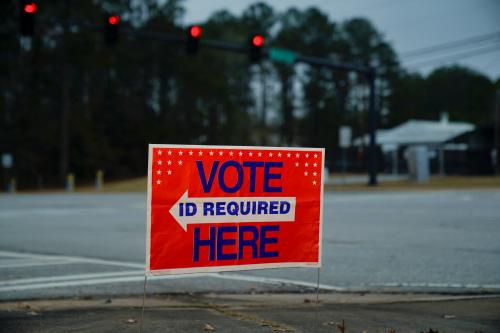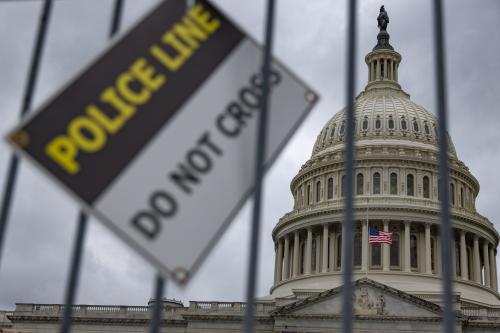Preface: The Continuity of Government
The Continuity of the Three Branches of Government. September 11th dispelled the United States’ naive attitude towards security of its homeland. The three airplanes that hit the World Trade Center towers and the Pentagon caused severe damage and a horrific loss of life. A fourth plane was downed in a field in Pennsylvania by brave passengers who stormed the cockpit. That fourth plane was headed toward Washington, likely towards the U.S. Capitol. Al Qaeda targeted our top government leaders. A lesser-known fifth plane – probably headed for the White House – was likely prevented from its course by the arrest of Zacarias Moussaoui. Had this part of the plan been successfully executed, September 11th would have brought additional tragedy in loss of life and destruction of symbolic buildings. It would have hindered the ability of our government to respond to the attack. In short, Al Qaeda has shown interest in incapacitating the leadership of our government. And where Al Qaeda has failed in the past, such as in the 1993 World Trade Center bombing, it has returned to strike again.
The Commission. The Continuity of Government Commission is a private AEI-Brookings commission funded by the Carnegie, Hewlett, Packard, and MacArthur Foundations. It is comprised of members with experience in various branches of government and expertise in the daily functioning of our government. It was founded in the fall of 2002 to consider how each of our three branches of government might reconstitute themselves after a catastrophic attack on Washington, D.C. and to make recommendations for statutory and constitutional changes that would improve the continuity of our basic institutions. In June of 2003, the commission issued its first report on the Continuity of Congress.1 In that report the commission unanimously recommended a constitutional amendment that would provide for filling mass vacancies or mass incapacitations in the U.S. House and Senate through temporary appointments until special elections could be held to fill the vacancies. Without such an amendment, an attack might cause Congress to fall below the quorum requirement for conducting business and potentially disable Congress for many months until the numerous vacancies could be filled. The report spawned much debate in Congress, including many hearings and the introduction of a variety of amendments to address this problem.
The Presidency. This is the second report of the Continuity of Government Commission. This report addresses our system of Presidential succession and how we would replace a president after a catastrophic terrorist attack to ensure the proper functioning of our government. Unlike the current provisions for congressional continuity which do not include any institutional protections in the case of an attack causing mass vacancies or mass incapacitations, there is a Presidential succession system in place. However, it is the finding of this commission that the current system would be inadequate in the face of a catastrophic attack that would kill or incapacitate multiple individuals in the line of succession. The current system must be corrected to ensure continuity in the executive branch.
SUMMARY OF CENTRAL RECOMMENDATION
PROBLEM: The current constitutional and legal provisions fail to take into account the possibility of a catastrophic attack on Washington, D.C. Since all individuals included in the Presidential line of succession are based in our nation’s capital, a catastrophic attack on the city could potentially kill or incapacitate many if not all of these individuals and cause significant confusion about who can assume the powers of the presidency. With the inclusion of members of Congress and acting cabinet secretaries in the line of succession, all of whom must resign from their current positions before assuming the presidency and can then be “bumped” from the presidency by an individual ranking higher in the line of succession, it is possible to have no one remaining in the line of succession. Current procedures leave our nation especially vulnerable at presidential inaugurations and State of the Union Addresses.
RECOMMENDATION: A reordering of the Presidential line of succession to: Vice President, Secretary of State, Secretary of the Treasury, Secretary of Defense, Attorney General, followed by four or five newly appointed individuals residing outside of Washington, D.C. A dual vacancy in the presidency and vice presidency during the first two years of a term should trigger a special election within five months. The winner of the election would serve the remainder of the term and would displace the temporary successor. The commission recommends removing Congressional leaders and acting secretaries from the line of succession to limit confusion over who can assume power. It also recommends reducing the time between the casting and counting of electoral votes as well as for Congress to clarify procedures for incapacitation and create guidelines for continuity in the event of an attack at the presidential inauguration or during the time period before the inauguration. If possible, the outgoing president should appoint some or all of the incoming president’s cabinet nominees prior to the inauguration to ensure individuals will remain in the line of succession. The commission believes these changes to the current provisions are necessary to ensure continuity of the United States’ Presidency when our nation is most vulnerable.

